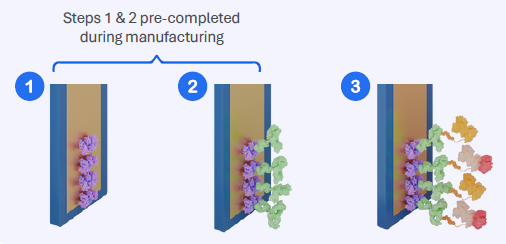Sponsored Content by AbselionReviewed by Olivia FrostNov 27 2025
His-tagging is a popular approach for protein purification, screening, and assay development because it enables simple affinity-based capture while preserving protein function.
His-tagged proteins have applications in structural biology, binding studies, and medicinal research. Measuring their concentration is critical for assessing expression, maximizing production, and monitoring construct stability.
While conventional methods such as SDS-PAGE or nickel-affinity columns can yield reasonable estimations, they frequently necessitate purification, are time-consuming, or lack measurable precision. Amperia™ provides a practical solution for quantifying His-tagged proteins in crude samples utilizing a premix competition assay.
The sensor-based format provides quick, repeatable results without the need for complex equipment or purification stages.
Assay format and workflow
Amperia uses a premix competition assay format to quantify His-tagged proteins. The sensor surface has anti-His capture sites, allowing for selective detection of His-tagged objects. During the test, the material is combined with an HRP-labeled His-tag detection reagent.
The analyte and detection reagent compete for the sensor's anti-His capture sites. Higher analyte concentrations occupy more sites, lowering detection reagent binding and signal intensity. This inverse signal relationship allows for precise quantification over a wide dynamic range.

Assay Workflow Schematic. (1) Sensor with streptavidin surface. (2) Biotinylated anti-His antibody bound to sensor. (3) Premixed sample and HRP-labelled His-tagged detection reagent applied, enabling signal generation. Image Credit: Abselion
The assay is performed utilizing Amperia's touchscreen-guided workflow, which includes built-in protocol templates that speed plate setup, sensor loading, and automated analysis, resulting in rapid, reproducible results and a simple setup process.
Source: Abselion
| Parameter |
Typical Value |
| Sample throughput |
Up to 40 samples per run |
| Total run time |
~ 65 min |
| Hands-on time |
~ 20 - 30 min |
| Detection Range |
nM‑scale |
| Format |
Premix Competition |
Note: Values shown are typical ranges based on internal testing. Actual throughput and hands-on time may vary depending on assay format, sample type, and workflow configuration. Detection range may vary depending on analyte affinity and assay conditions.

Image Credit: Abselion
Data highlights
Amperia allows for the accurate quantification of various His-tagged proteins, with consistent performance across a wide variety of molecular weights and tag configurations. The assay works in complicated matrices, including crude lysates, and provides reliable standard curves for many recombinant targets.

Representative standard curves for various His-tagged proteins. Image Credit: Abselion
Where Amperia supports His-tagged protein workflows
His-tagged proteins are employed in a variety of research and development applications. Amperia™ allows fast and reproducible measurement of complicated samples, facilitating decision-making in expression and screening operations.
Source: Abselion
| Use Case |
Typical Sample Type |
Value |
| Expression monitoring |
Crude lysate or supernatant |
Track yield across constructs and conditions |
| Clone or construct screening |
Crude lysate |
Compare expression across candidates |
| Process optimization |
Clarified or partially purified |
Evaluate effects of media or expression parameters |
| Purification step evaluation |
In-process fractions |
Assess recovery or binding efficiency |
About Abselion
Abselion started in 2018, at that time under the name HexagonFab, in a small corner of a laboratory at the University of Cambridge.
We set out with the humble goal to make protein research simpler. Scientists should be able to pursue their passion for discovery and innovation, rather than spend their valuable time with tedious, manual tasks. With RED we had access to the ideal technology to create this product. A product that is so compact that it could fit on every bench, and so affordable that it is accessible to everyone. Over the years we have designed, built and tested our first product Amperia and we’re proud to introduce it to the world.
Sponsored Content Policy: News-Medical.net publishes articles and related content that may be derived from sources where we have existing commercial relationships, provided such content adds value to the core editorial ethos of News-Medical.Net which is to educate and inform site visitors interested in medical research, science, medical devices and treatments.